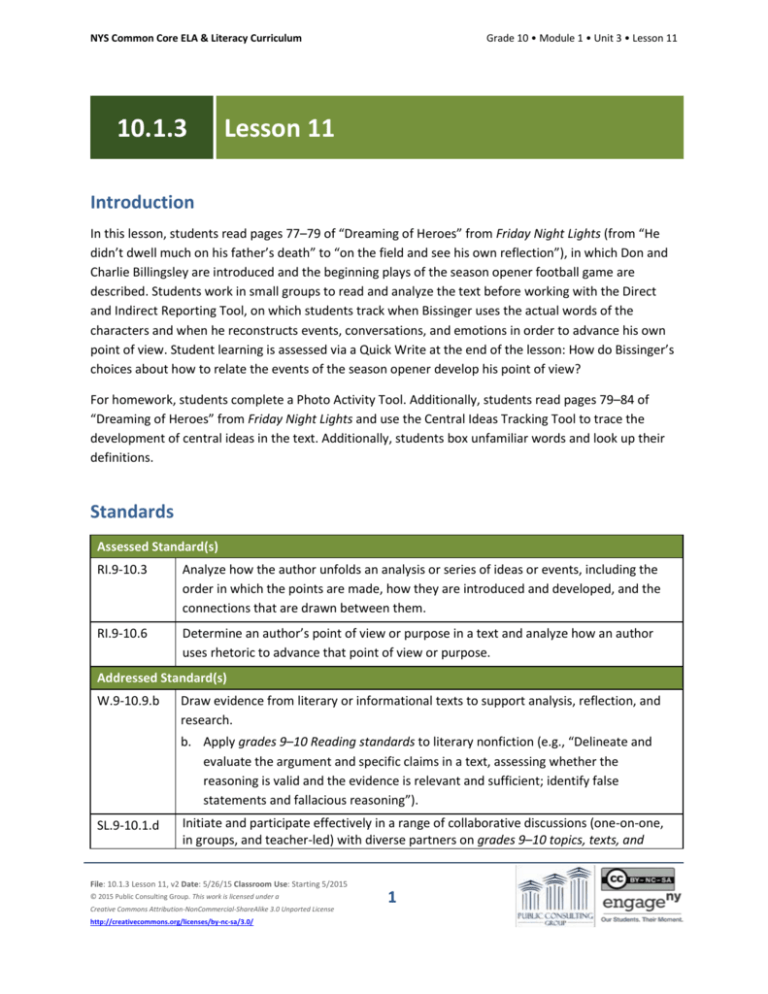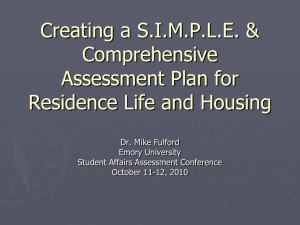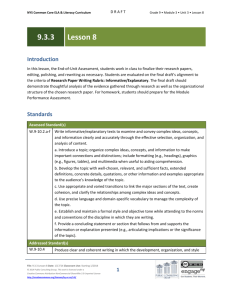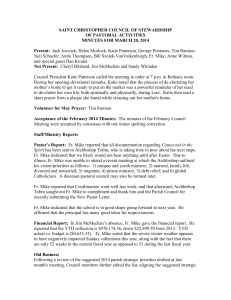Grade 10 ELA Module 1, Unit 3, Lesson 11
advertisement

NYS Common Core ELA & Literacy Curriculum 10.1.3 Grade 10 • Module 1 • Unit 3 • Lesson 11 Lesson 11 Introduction In this lesson, students read pages 77–79 of “Dreaming of Heroes” from Friday Night Lights (from “He didn’t dwell much on his father’s death” to “on the field and see his own reflection”), in which Don and Charlie Billingsley are introduced and the beginning plays of the season opener football game are described. Students work in small groups to read and analyze the text before working with the Direct and Indirect Reporting Tool, on which students track when Bissinger uses the actual words of the characters and when he reconstructs events, conversations, and emotions in order to advance his own point of view. Student learning is assessed via a Quick Write at the end of the lesson: How do Bissinger’s choices about how to relate the events of the season opener develop his point of view? For homework, students complete a Photo Activity Tool. Additionally, students read pages 79–84 of “Dreaming of Heroes” from Friday Night Lights and use the Central Ideas Tracking Tool to trace the development of central ideas in the text. Additionally, students box unfamiliar words and look up their definitions. Standards Assessed Standard(s) RI.9-10.3 Analyze how the author unfolds an analysis or series of ideas or events, including the order in which the points are made, how they are introduced and developed, and the connections that are drawn between them. RI.9-10.6 Determine an author’s point of view or purpose in a text and analyze how an author uses rhetoric to advance that point of view or purpose. Addressed Standard(s) W.9-10.9.b Draw evidence from literary or informational texts to support analysis, reflection, and research. b. Apply grades 9–10 Reading standards to literary nonfiction (e.g., “Delineate and evaluate the argument and specific claims in a text, assessing whether the reasoning is valid and the evidence is relevant and sufficient; identify false statements and fallacious reasoning”). SL.9-10.1.d Initiate and participate effectively in a range of collaborative discussions (one-on-one, in groups, and teacher-led) with diverse partners on grades 9–10 topics, texts, and File: 10.1.3 Lesson 11, v2 Date: 5/26/15 Classroom Use: Starting 5/2015 © 2015 Public Consulting Group. This work is licensed under a Creative Commons Attribution-NonCommercial-ShareAlike 3.0 Unported License http://creativecommons.org/licenses/by-nc-sa/3.0/ 1 NYS Common Core ELA & Literacy Curriculum Grade 10 • Module 1 • Unit 3 • Lesson 11 issues, building on others’ ideas and expressing their own clearly and persuasively. d. Respond thoughtfully to diverse perspectives, summarize points of agreement and disagreement, and, when warranted, qualify or justify their own views and understanding and make new connections in light of the evidence and reasoning presented. L.9-10.3 Apply knowledge of language to understand how language functions in different contexts, to make effective choices for meaning or style, and to comprehend more fully when reading or listening. L.9-10.4.a Determine or clarify the meaning of unknown and multiple-meaning words and phrases based on grades 9–10 reading and content, choosing flexibly from a range of strategies. a. Use context (e.g., the overall meaning of a sentence, paragraph, or text; a word’s position or function in a sentence) as a clue to the meaning of a word or phrase. Assessment Assessment(s) Student learning is assessed via a Quick Write at the end of the lesson. Students respond to the following prompt, citing textual evidence to support analysis and inferences drawn from the text. How do Bissinger’s choices about how to relate the events of the season opener develop his point of view? High Performance Response(s) A High Performance Response should: Identify Bissinger’s choices about how to relate the events of the season opener (e.g., Bissinger shifts between using the actual words of the people in his account and reconstructing conversations, events, thoughts, or feelings). Analyze what Bissinger’s choices about how to relate the events of the season opener suggest about his point of view (e.g., Bissinger shifts between direct and indirect accounts of the memories, thoughts, and feelings of the people of Odessa in order to develop his point of view about the importance of football to the community of Odessa. In his account of the first game of the season, Bissinger states, “Everyone knew what was at stake” (p. 78). There are no quotation marks or words attributing these thoughts and feelings to anyone in Odessa, but Bissinger presents them as though they are a fact and uses them to express his point of view that football is an event that “everyone” in Odessa cares about. Bissinger’s account of the coach’s pre-game speech, on the other hand, is very straightforward and uses quotation marks to indicate the exact words he spoke to the boys, “That 1988 season is four and a half minutes away … Let’s have a great one” (p. 78). Bissinger’s introduction uses indirect reporting, written in a style very different from that in which File: 10.1.3 Lesson 11, v2 Date: 5/26/15 Classroom Use: Starting 5/2015 © 2015 Public Consulting Group. This work is licensed under a Creative Commons Attribution-NonCommercial-ShareAlike 3.0 Unported License http://creativecommons.org/licenses/by-nc-sa/3.0/ 2 NYS Common Core ELA & Literacy Curriculum Grade 10 • Module 1 • Unit 3 • Lesson 11 the people of Odessa speak, to advance his point of view that football is of immense importance to the community.). Vocabulary Vocabulary to provide directly (will not include extended instruction) jiggering (v.) – manipulating or altering, especially in order to get something done illegally or unethically cherished (v.) – held or treated as dear succinct (adj.) – expressed in few words meticulous (adj.) – taking or showing extreme care about minute details; precise; thorough tailback (n.) – in American football, the offensive player who lines up farthest behind the line of scrimmage debut (n.) – first appearance on a stage, on television, etc. balmy (adj.) – mild and refreshing Vocabulary to teach (may include direct word work and/or questions) poise (n.) – dignified, self-confident manner or bearing Additional vocabulary to support English Language Learners (to provide directly) immaculate (adj.) – perfectly clean methodical (adj.) – done by using a careful and organized procedure Lesson Agenda/Overview Student-Facing Agenda % of Lesson Standards & Text: Standards: RI.9-10.3, RI.9-10.6, W.9-10.9.b, SL.9-10.1.d, L.9-10.3, L.9-10.4.a Text: “Dreaming of Heroes” from Friday Night Lights by H. G. Bissinger, pages 77–79 Learning Sequence: 1. Introduction of Lesson Agenda 2. Homework Accountability 3. Masterful Reading 1. 15% 2. 10% 3. 10% File: 10.1.3 Lesson 11, v2 Date: 5/26/15 Classroom Use: Starting 5/2015 © 2015 Public Consulting Group. This work is licensed under a Creative Commons Attribution-NonCommercial-ShareAlike 3.0 Unported License http://creativecommons.org/licenses/by-nc-sa/3.0/ 3 NYS Common Core ELA & Literacy Curriculum 4. 5. 6. 7. Grade 10 • Module 1 • Unit 3 • Lesson 11 Reading and Discussion Direct and Indirect Reporting Tool Quick Write Closing 4. 5. 6. 7. 15% 35% 10% 5% Materials Student copies of the 10.1 Common Core Learning Standards Tool (refer to 10.1.1 Lesson 1) Copies of the Direct and Indirect Reporting Tool for each student Student copies of the Short Response Rubric and Checklist (refer to 10.1.1 Lesson 1) Copies of the Photo Activity Tool for each student Student copies of the Central Ideas Tracking Tool (refer to 10.1.2 Lesson 2)—students may need additional blank copies Learning Sequence How to Use the Learning Sequence Symbol Type of Text & Interpretation of the Symbol 10% no symbol Percentage indicates the percentage of lesson time each activity should take. Plain text indicates teacher action. Bold text indicates questions for the teacher to ask students. Italicized text indicates a vocabulary word. Indicates student action(s). Indicates possible student response(s) to teacher questions. Indicates instructional notes for the teacher. Activity 1: Introduction of Lesson Agenda 15% Begin by reviewing the agenda and the assessed standards for this lesson: RI.9-10.3 and RI.9-10.6. In this lesson, students explore how Bissinger combines actual and reconstructed events to advance his point of view while describing the beginning plays of the season opener. Students look at the agenda. Instruct students to take out their copies of the 10.1 Common Core Learning Standards Tool. Inform students that in this lesson they begin to work with three new standards: RI.9-10.6, W.9-10.9.b, and L.9- File: 10.1.3 Lesson 11, v2 Date: 5/26/15 Classroom Use: Starting 5/2015 © 2015 Public Consulting Group. This work is licensed under a Creative Commons Attribution-NonCommercial-ShareAlike 3.0 Unported License http://creativecommons.org/licenses/by-nc-sa/3.0/ 4 NYS Common Core ELA & Literacy Curriculum Grade 10 • Module 1 • Unit 3 • Lesson 11 10.3. Instruct students to individually read the standards on their tools and assess their familiarity with and mastery of them. Students read and assess their familiarity with standards RI.9-10.6, W.9-10.9.b, and L.9-10.3. Instruct students to talk in pairs about what they think standard RI.9-10.6 means. Lead a brief discussion about the standard. Student responses may include: o o o Consider the author’s point of view. Consider the author’s purpose in writing an informational text. Analyze how the author furthers that point of view and/or purpose in his or her writing. Explain to students that rhetoric means “the art of effective or persuasive writing or speaking.” Instruct students to talk in pairs about what they think standard W.9-10.9.b means. Lead a brief discussion about the standard. Student responses may include: o o Use evidence from literary nonfiction to support analysis, reflection, and research. Use evidence from literary nonfiction to support grades 9–10 reading standards for informational texts, including literary nonfiction. Instruct students to talk in pairs about what they think standard L.9-10.3 means. Lead a brief discussion about the standards. Student responses may include: o o o Think about how language is used differently in different situations. Choose language that is appropriate for expressing ideas clearly or for establishing an appropriate style. Read and listen carefully in order to notice how writers and speakers use language differently in different situations. Activity 2: Homework Accountability 10% Instruct students to take out their responses to the first part of the homework assignment. (Reread pages 73–76 of the chapter “Dreaming of Heroes” from Friday Night Lights and use the Central Ideas Tracking Tool to trace the development of central ideas in the text.) See the Model 10.1.3 Central Ideas Tracking Tool for sample student responses. File: 10.1.3 Lesson 11, v2 Date: 5/26/15 Classroom Use: Starting 5/2015 © 2015 Public Consulting Group. This work is licensed under a Creative Commons Attribution-NonCommercial-ShareAlike 3.0 Unported License http://creativecommons.org/licenses/by-nc-sa/3.0/ 5 NYS Common Core ELA & Literacy Curriculum Grade 10 • Module 1 • Unit 3 • Lesson 11 Instruct student pairs to share and discuss the vocabulary words they identified and defined in the previous lesson’s homework. Students may identify the following words: jiggering, cherished, succinct, meticulous, tailback, debut, and balmy. Differentiation Consideration: Students may also identify the following words: immaculate and methodical. Definitions are provided in the Vocabulary box in this lesson. Activity 3: Masterful Reading 10% Have students listen to a masterful reading of pages 77–79 of “Dreaming of Heroes” (from “He didn’t dwell much on his father’s death” to “on the field and see his own reflection”). Consider pausing several times during the masterful reading to allow students time to write down initial reactions and questions. Students follow along, reading silently. Differentiation Consideration: Consider posting or projecting the following guiding question to support students in their reading throughout this lesson: How does Bissinger distinguish his point of view from that of the people he describes? Activity 4: Reading and Discussion 15% Instruct students to form small groups. Post or project the questions below for students to discuss in their groups. Instruct students to annotate for point of view throughout the reading and discussion, using the code POV. This annotation exercise supports students’ engagement with W.9-10.9.b, which addresses the use of textual evidence in writing. Instruct student groups to reread pages 77–79 (from “He didn’t dwell much on his father’s death” to “on the field and see his own reflection”) and answer the following questions before sharing out with the class. What does Bissinger’s report of the fans’ responses to the team on page 78 suggest about what the Permian Panthers represent to their community? Student responses may include: File: 10.1.3 Lesson 11, v2 Date: 5/26/15 Classroom Use: Starting 5/2015 © 2015 Public Consulting Group. This work is licensed under a Creative Commons Attribution-NonCommercial-ShareAlike 3.0 Unported License http://creativecommons.org/licenses/by-nc-sa/3.0/ 6 NYS Common Core ELA & Literacy Curriculum o o o Grade 10 • Module 1 • Unit 3 • Lesson 11 The team’s success represents the community’s pride, as is evident when Bissinger reports, “Everyone knew what was at stake” (p. 78). This sentence suggests that more than just the outcome of a single game or a team’s season is at stake; the community’s pride is also at stake. The team represents the community itself. Bissinger describes the fans “squealing in delight,” and “yelling the war cry ... in frantic unison” (p. 78), demonstrating their enthusiastic support for the team and their hope that the team will succeed. The phrases “war cry” and “frantic unison” suggest that the community feels as though it is part of the team, not just a crowd of spectators, and the team represents them when it plays against teams from other communities. The team represents the “heroes” of the community. As the team comes into the stadium, Bissinger describes the “eight thousand” fans rising “to give a standing ovation” and a little girl “put[ting] her hand to her mouth, as if she had seen something incredible” (p. 78), establishing that the community idolizes the players as “heroes.” Differentiation Consideration: If students struggle, consider asking the following scaffolding question: How does Bissinger’s description of Mike Winchell on the field clarify the meaning of poise in this context (pp, 78–79)? Bissinger describes Mike using phrases like “looked good” (p. 78), “throwing nicely,” and “no rushed throws” (p. 79). Therefore, the related description poise is a description of quality in form, grace, or elegance. Consider drawing students’ attention to the application of L.9-10.4.a through the process of using context to make meaning of unknown words. What can you infer about what Don represents to Charlie Billingsley, based on what Charlie sees on the field? Bissinger reports that Charlie sees “his own reflection” (p. 79) on the football field. Charlie’s memories of his own success may prevent him from distinguishing between his former expectations for himself and his current expectations for his son. Therefore, Don represents Charlie’s past and his failure to meet his own personal expectations of success. Lead a brief whole-class discussion of student responses. File: 10.1.3 Lesson 11, v2 Date: 5/26/15 Classroom Use: Starting 5/2015 © 2015 Public Consulting Group. This work is licensed under a Creative Commons Attribution-NonCommercial-ShareAlike 3.0 Unported License http://creativecommons.org/licenses/by-nc-sa/3.0/ 7 NYS Common Core ELA & Literacy Curriculum Grade 10 • Module 1 • Unit 3 • Lesson 11 Activity 5: Direct and Indirect Reporting Tool 35% Distribute copies of the Direct and Indirect Reporting Tool to students. Read the directions on the tool aloud. Instruct students to write in the left-hand column (“Direct Reporting”) what the people of Odessa actually say. Encourage students to look for quotation marks and dialogue markers to help them to isolate portions of the text where Bissinger directly cites the point of view of the residents of Odessa. Instruct students to write in the right-hand column (“Indirect Reporting”) those portions of the text where Bissinger is making inferences about other people’s thoughts and feelings. Model for students how to use the tool, using the examples in the Model Direct and Indirect Reporting Tool. In the left-hand column, model copying a relevant detail and ask students to point to the textual evidence that indicates that this detail is an example of direct reporting. Call attention to phrases such as “as he later put it” (p. 74) to indicate a point where Bissinger is documenting something Mike said. Model how to record who is being documented (i.e., Mike Winchell). Repeat the same process for the right-hand column, pointing students to the absence of quotation marks or dialogue marking phrases to indicate indirect reporting. Repeat this process a second time with the evidence from page 75, found on the Model Direct and Indirect Reporting Tool. This time, ask students to provide the observations. Instruct students to copy down this modeling for reference. Instruct students to work in their groups to fill in the tool. Remind students to record brief observations about how they know whether the key details they collect are examples of direct or indirect reporting in order to support their choices. Consider drawing students’ attention to their application of SL.9-10.1.d through the process of justifying their own views and understanding and making new connections in light of the evidence and reasoning presented. Students work in small groups to complete the Direct and Indirect Reporting Tool. See Model Direct and Indirect Reporting Tool for sample student responses. Lead a brief whole-class discussion of student responses. Consider drawing students’ attention to their application L.9-10.3 through their analysis of how Bissinger makes “effective choices for meaning or style” when alternating between direct and indirect reporting. Activity 6: Quick Write 10% Instruct students to respond briefly in writing to the following prompt: File: 10.1.3 Lesson 11, v2 Date: 5/26/15 Classroom Use: Starting 5/2015 © 2015 Public Consulting Group. This work is licensed under a Creative Commons Attribution-NonCommercial-ShareAlike 3.0 Unported License http://creativecommons.org/licenses/by-nc-sa/3.0/ 8 NYS Common Core ELA & Literacy Curriculum Grade 10 • Module 1 • Unit 3 • Lesson 11 How do Bissinger’s choices about how to relate the events of the season opener develop his point of view? Ask students to use this lesson’s vocabulary wherever possible in their written responses. Remind students to use the Short Response Rubric and Checklist to guide their written responses. Students listen and read the Quick Write prompt. Display the prompt for students to see, or provide the prompt in hard copy. Transition to the independent Quick Write. Students independently answer the prompt using evidence from the text. See the High Performance Response at the beginning of this lesson. Activity 7: Closing 5% Distribute a copy of the Photos Activity Tool to each student and read the directions on the tool aloud. Display and distribute the homework assignment. For homework, instruct students to complete the Photo Activity Tool and come to the next lesson prepared to discuss their responses. In addition, instruct students to read pages 79–84 (from “There were some kids who came out of Odessa” to “At least for as long as the season lasted”) and use the Central Ideas Tracking Tool to trace the development of central ideas in the text. Also, direct students to box any unfamiliar words and look up their definitions. Instruct them to choose the definition that makes the most sense in context and write a brief definition above or near the word in the text. Homework Complete the Photo Activity Tool and come to the next lesson prepared to discuss your responses. In addition, read pages 79–84 of “Dreaming of Heroes” from Friday Night Lights (from “There were some kids who came out of Odessa” to “At least for as long as the season lasted”), and use the Central Ideas Tracking Tool to trace the development of central ideas in the text. Also, box any unfamiliar words and look up their definitions. Choose the definition that makes the most sense in context, and write a brief definition above or near the word in the text. File: 10.1.3 Lesson 11, v2 Date: 5/26/15 Classroom Use: Starting 5/2015 © 2015 Public Consulting Group. This work is licensed under a Creative Commons Attribution-NonCommercial-ShareAlike 3.0 Unported License http://creativecommons.org/licenses/by-nc-sa/3.0/ 9 NYS Common Core ELA & Literacy Curriculum Grade 10 • Module 1 • Unit 3 • Lesson 11 Model Central Ideas Tracking Tool Name: Class: Date: Directions: Identify the central ideas that you encounter throughout the texts in this unit. Trace the development of those ideas by noting how the author introduces, develops, or refines these ideas in the texts. Cite textual evidence to support your work. Text: “Dreaming of Heroes” from Friday Night Lights by H. G. Bissenger Page # Central Ideas Notes and Connections Page 73 Expectations Billy uses his dying words to set his expectations for Mike. He “warned Mike that the pitchers were going to get better now and the home runs wouldn’t come as easily as they once had. He told him he had to go to college, there could be no two ways about it. He let him know it was okay to have a little beer every now and then … but he admonished him to never, ever try drugs. And he told his son he loved him” (p. 73). Page 74 Identity Joe Bill, Mike’s brother, tells Bissinger that Mike is “that kind of kid, quiet, loyal, unfailingly steady” and Bissinger reports, “Typically, he [Mike] didn’t worry about himself. He worried about his grandmother,” establishing Mike’s identity as a solid and reliable boy. Page 74 Identity Mike wants to leave Odessa because it “bore no secrets nor ever inspired the imagination” and Mike longs “for lakes and trees and hills, for serene places where he could take walks by himself,” suggesting that Mike is not a perfect fit for Odessa. Page 74 Identity/expectations Joe Bill convinces Mike to stay in Odessa by using “the most powerful pull there was for a thirteen-year-old boy living in Odessa, really the only one that gave a kid something to dream about – the power of Permian football,” establishing that football has a strong appeal for Mike (and for many boys in Odessa). Joe Bill describes “how Mike had always wanted to wear the black and white and how much he would regret if he didn’t’” and Bissinger says Mike “had already carried that dream for a long time, and … it was File: 10.1.3 Lesson 11, v2 Date: 5/26/15 Classroom Use: Starting 5/2015 © 2015 Public Consulting Group. This work is licensed under a Creative Commons Attribution-NonCommercial-ShareAlike 3.0 Unported License http://creativecommons.org/licenses/by-nc-sa/3.0/ 10 NYS Common Core ELA & Literacy Curriculum Grade 10 • Module 1 • Unit 3 • Lesson 11 impossible to let it go,” establishing the lure of football as part of Mike’s identity and as an expectation he holds for himself. Page 74 Tradition Joe Bill encourages Mike to stay in Odessa so he can enjoy the “sense of allegiance and tradition” that Permian football offers. He reminds Mike that “he had always wanted to wear the black and white,” referring to the school colors that carry a sense of tradition for the town. Page 74 Identity Billy and Mike have a close relationship that influences Mike’s identity. His grandmother says, “His daddy worshiped him … He sure loved that little boy” and Mike says, “When he died, I just thought that the best person in the world had just died.” Page 75 Identity Bissinger uses parallel structure to emphasize how much a part of Mike Billy is. He uses the phrase “Billy and Mike” in italics to begin a long description of the many activities the father and son did together: “There was Mike ... looking into his dad’s face at Christmastime. And there was Billy …There was Mike at the flea markets … There was Billy following him … There they were together.” The close relationship suggests that Billy is an important part of Mike’s identity. Page 75 Identity Mike is a gifted athlete. His father teaches him to play ball and “[u]nder the demanding tutelage of his father, Mike … became the stuff of legend.” When Billy dies, Mike loses his confidence: “[t]he gift was always there, but he began to question it, doubt it, brood over it.” Page 75 Identity Mike wonders about what makes him different from other kids, asking himself, “Why in the hell can I hit these home runs? … Why could I do it when other kids couldn’t?” Page 76 Expectations Mike expects himself to be successful in order to improve his circumstances. His brother says, “Me and him talked about not havin’ a nice home or a nice car and how those things were not important … I told him, you make your grades and stay in sports, you’ll one day have those things.” File: 10.1.3 Lesson 11, v2 Date: 5/26/15 Classroom Use: Starting 5/2015 © 2015 Public Consulting Group. This work is licensed under a Creative Commons Attribution-NonCommercial-ShareAlike 3.0 Unported License http://creativecommons.org/licenses/by-nc-sa/3.0/ 11 NYS Common Core ELA & Literacy Curriculum Grade 10 • Module 1 • Unit 3 • Lesson 11 Page 76 Expectations Mike understands his teammates’ expectations and his own expectations of himself and finds the pressure of meeting those expectations difficult. “When the pressure was on … something seemed to unravel inside him.” Page 76 Expectations Mike expects himself to have a great football season during his senior year. As the season begins, “[h]e seemed ready, ready for something truly wonderful to happen to him.” He is ready to be a football hero. File: 10.1.3 Lesson 11, v2 Date: 5/26/15 Classroom Use: Starting 5/2015 © 2015 Public Consulting Group. This work is licensed under a Creative Commons Attribution-NonCommercial-ShareAlike 3.0 Unported License http://creativecommons.org/licenses/by-nc-sa/3.0/ 12 NYS Common Core ELA & Literacy Curriculum Grade 10 • Module 1 • Unit 3 • Lesson 11 Direct and Indirect Reporting Tool (Side 1) Name: Class: Date: Directions: Reread pages 77–79 of “Dreaming of Heroes” (from “He didn’t dwell much on his father’s death” to “on the field and see his own reflection”). In the first column, record examples of direct reporting that use the actual words used by the people of Odessa to describe their thoughts or memories. In the second column, record examples of indirect reporting that use Bissinger’s words to report the thoughts or memories of the people of Odessa. For each quote, support your reasoning with evidence from the text. Be sure to reference characters and page numbers. Then respond to the questions below. Direct Reporting: What do the people of Odessa actually believe or remember? Indirect Reporting: What does Bissinger infer the people of Odessa believe or remember? How do you know? How do you know? File: 10.1.3 Lesson 11, v2 Date: 5/26/15 Classroom Use: Starting 5/2015 © 2015 Public Consulting Group. This work is licensed under a Creative Commons Attribution-NonCommercial-ShareAlike 3.0 Unported License http://creativecommons.org/licenses/by-nc-sa/3.0/ 13 NYS Common Core ELA & Literacy Curriculum Grade 10 • Module 1 • Unit 3 • Lesson 11 Direct and Indirect Reporting Tool (Side 2) Name: Class: Date: 1. How does the voice of Mike Winchell in the left-hand column compare to Mike’s voice in the righthand column? 2. What might this comparison reveal about the Bissinger’s reasons for using indirect reporting? Consider what elements of the text Bissinger’s indirect reporting emphasizes. 3. How does Bissinger unfold the events of the Season Opener? Use the details you tracked on your Direct and Indirect Reporting Tool to support your response. 4. How does Bissinger’s use of direct and indirect reporting raise questions about point of view in this text? File: 10.1.3 Lesson 11, v2 Date: 5/26/15 Classroom Use: Starting 5/2015 © 2015 Public Consulting Group. This work is licensed under a Creative Commons Attribution-NonCommercial-ShareAlike 3.0 Unported License http://creativecommons.org/licenses/by-nc-sa/3.0/ 14 NYS Common Core ELA & Literacy Curriculum Grade 10 • Module 1 • Unit 3 • Lesson 11 Model Direct and Indirect Reporting Tool (Side 1) Name: Class: Date: Directions: Reread pages 77–79 of “Dreaming of Heroes” (from “He didn’t dwell much on his father’s death” to “on the field and see his own reflection”). In the first column, record examples of direct reporting that use the actual words used by the people of Odessa to describe their thoughts or memories. In the second column, record examples of indirect reporting that use Bissinger’s words to report the thoughts or memories of the people of Odessa. For each quote, support your reasoning with evidence from the text. Be sure to reference characters and page numbers. Then respond to the questions below. Direct Reporting: What do the people of Odessa actually believe or remember? Indirect Reporting: What does Bissinger infer the people of Odessa believe or remember? How do you know? How do you know? Mike Winchell: “he said he had never met anyone more honest, or more clever, or more dependable … and how he had bought him every piece of sports equipment that had ever been invented” (p. 77). Mike Winchell: “And Mike also knew how much Billy Winchell would have cherished seeing him on this September night, dressed in the immaculate black and white of the Permian Panthers, moments away from playing out the dream that had kept him in Odessa” (p. 77). “He said” and “he talked.” No quotation marks. The language is more formal than the quotes of Mike’s words. Unlikely that Mike would really say that he knew Billy would have “cherished” seeing him on the field. This sounds more literary and more like something Bissinger would say or write. Julia Winchell: “He would have liked to have lived for Mike’s sake,’ said Julia Winchell. ‘He sure would have been proud of him’” (p. 77). Quotations marks, and “said Julia Winchell.” Tam Hollingshead: “He knew what the jitters of the season opener could do, how the most talented kid could come unglued in the sea of all those lights and those thousands of fans” (p. 77). No quotations marks. Unlikely that the coach would refer to “the sea of all those lights” in casual conversation. This sounds as though Bissinger is summarizing a conversation he had with Tam Hollingshead but is not using the actual words of the conversation. File: 10.1.3 Lesson 11, v2 Date: 5/26/15 Classroom Use: Starting 5/2015 © 2015 Public Consulting Group. This work is licensed under a Creative Commons Attribution-NonCommercial-ShareAlike 3.0 Unported License http://creativecommons.org/licenses/by-nc-sa/3.0/ 15 NYS Common Core ELA & Literacy Curriculum Tam Hollingshead: “‘Some of you haven’t played before, been in the spotlight,’ said assistant coach Tam Hollingshead ... He offered some succinct advice. ‘Have some fun, hustle your ass, and stick the hell out of ‘em’” (p. 77). Quotation marks, prefaced by “said” and “offered some succinct advice.” Grade 10 • Module 1 • Unit 3 • Lesson 11 Charlie Billingsley: “Charlie Billingsley ... still had powerful memories of those days … it seemed impossible not to look down on the field and see his own reflection” (p. 79). No quotation marks or “he said.” The language is more formal than the quotes of Charlie’s words and it is unlikely that he would talk about “see[ing] his own reflection” on the field. This sounds as though Billingsley imagines it would be hard for Charlie not to see himself on the field, not necessarily something Charlie said himself. File: 10.1.3 Lesson 11, v2 Date: 5/26/15 Classroom Use: Starting 5/2015 © 2015 Public Consulting Group. This work is licensed under a Creative Commons Attribution-NonCommercial-ShareAlike 3.0 Unported License http://creativecommons.org/licenses/by-nc-sa/3.0/ 16 NYS Common Core ELA & Literacy Curriculum Grade 10 • Module 1 • Unit 3 • Lesson 11 Model Actual and Reconstructed Details Tool (Side 2) Name: Class: Date: 1. How does the voice of Mike Winchell in the left-hand column compare to Mike’s voice in the righthand column? Mike’s voice sounds different in each column. In the direct quotes that Bissinger provides, Mike’s voice is casual. Many words are spelled without the final consonant and the grammar is not always standard so that the reader will hear the way Mike actually speaking. In the righthand column the voice is formal and grammatically correct. 2. What might this comparison reveal about Bissinger’s reasons for using indirect reporting? Consider what elements of the text Bissinger’s indirect reporting emphasizes. The text in the right-hand column provides Bissinger an opportunity to express his own insights into people and their motivations and their feelings that they may not have explicitly stated themselves. He emphasizes underlying motivations and inner thoughts. 3. How does Bissinger unfold the events of the season opener? Use the details you tracked on your Direct and Indirect Reporting Tool to support your response. H. G. Bissinger unfolds the events of the season opener by recording things people said and did. Bissinger also adds the thoughts of the people who are there, and details their past in ways that he probably couldn’t know for sure, as when he describes things that had “always” been true about Mike Winchell, even though the author hasn’t known Mike for more than a year. The events unfold in a combination of memories, observations, and descriptions. 4. How does Bissinger’s use of direct and indirect reporting raise questions about point of view in this text? Bissinger’s details include both thoughts and feelings that Mike personally shared with him and thoughts and feelings that Bissinger seems to infer, so it is difficult sometimes to know whether Bissinger is reporting Mike’s point of view or his own. File: 10.1.3 Lesson 11, v2 Date: 5/26/15 Classroom Use: Starting 5/2015 © 2015 Public Consulting Group. This work is licensed under a Creative Commons Attribution-NonCommercial-ShareAlike 3.0 Unported License http://creativecommons.org/licenses/by-nc-sa/3.0/ 17 NYS Common Core ELA & Literacy Curriculum Grade 10 • Module 1 • Unit 3 • Lesson 11 Photo Activity Tool Name: Class: Date: Directions: Read the beginning of the Preface on page xi (from “Maybe it was a suddenly acute awareness” to “I knew I had to go there”) and the List of Illustrations on page 368 before answering the questions below. Who are the people in these photos? How do you know? Why might Bissinger choose to include these photos here? How does the presence of these photos inform your understanding of Bissinger’s relationship to the residents of Odessa? File: 10.1.3 Lesson 11, v2 Date: 5/26/15 Classroom Use: Starting 5/2015 © 2015 Public Consulting Group. This work is licensed under a Creative Commons Attribution-NonCommercial-ShareAlike 3.0 Unported License http://creativecommons.org/licenses/by-nc-sa/3.0/ 18







